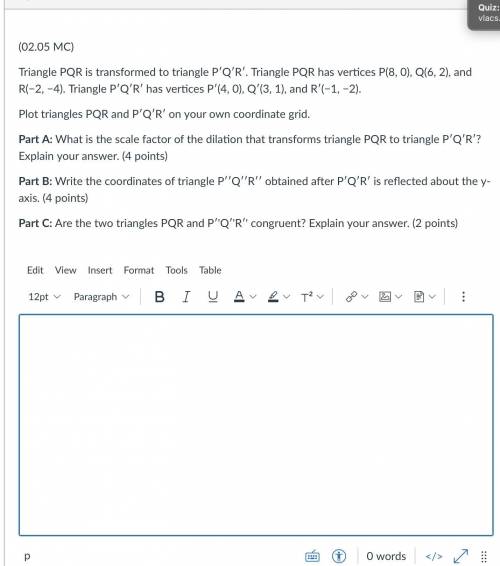
Mathematics, 07.12.2021 17:40 samantha9014
Triangle PQR is transformed to triangle P′Q′R′. Triangle PQR has vertices P(8, 0), Q(6, 2), and R(−2, −4). Triangle P′Q′R′ has vertices P′(4, 0), Q′(3, 1), and R′(−1, −2).
Plot triangles PQR and P′Q′R′ on your own coordinate grid.
Part A: What is the scale factor of the dilation that transforms triangle PQR to triangle P′Q′R′? Explain your answer. (4 points)
Part B: Write the coordinates of triangle P′′Q′′R′′ obtained after P′Q′R′ is reflected about the y-axis. (4 points)
Part C: Are the two triangles PQR and P′'Q′'R′' congruent? Explain your answer. (2 points)


Answers: 3


Other questions on the subject: Mathematics

Mathematics, 21.06.2019 20:00, alisonlebron15
An investment decreases in value by 30% in the first year and decreases by 40% in the second year. what is the percent decrease in percentage in the investment after two years
Answers: 1

Mathematics, 21.06.2019 21:20, DisneyGirl11
The edge of a cube was found to be 30 cm with a possible error in measurement of 0.4 cm. use differentials to estimate the maximum possible error, relative error, and percentage error in computing the volume of the cube and the surface area of the cube. (round your answers to four decimal places.) (a) the volume of the cube maximum possible error cm3 relative error percentage error % (b) the surface area of the cube maximum possible error cm2 relative error percentage error %
Answers: 3

Mathematics, 22.06.2019 02:00, Renabelle5604
Which of the following is not a solution to the inequality graphed below? (-2, -4)(-1, -5)(0, -3)(2, -1)which of the following is a solution to the inequality graphed below? select all that apply.(-3, -3)(-1, -1)(-3, -1)(2, 2)
Answers: 1
You know the right answer?
Triangle PQR is transformed to triangle P′Q′R′. Triangle PQR has vertices P(8, 0), Q(6, 2), and R(−2...
Questions in other subjects:



History, 06.12.2019 00:31

Chemistry, 06.12.2019 00:31

Mathematics, 06.12.2019 00:31







